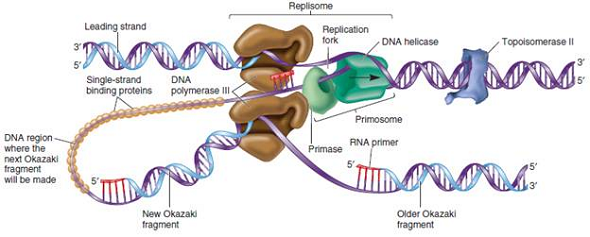
Genetics: Analysis and Principles 5th Edition by Robert Brooker
Edition 5ISBN: 978-0073525341
Genetics: Analysis and Principles 5th Edition by Robert Brooker
Edition 5ISBN: 978-0073525341 Exercise 43
Obtain two strings of different colors (e.g., black and white) that are the same length. A length of 20 inches is sufficient. Tie a knot at one end of the black string, and tie a knot at one end of the white string. Each knot designates the 5 end of your strings. Make a double helix with your two strings. Now tape one end of the double helix to a table so that the tape is covering the knot on the black string
a. Pretend your hand is DNA helicase and use your hand to unravel the double helix, beginning at the end that is not taped to the table. Should your hand be sliding along the white string or the black string
B. As in Figure 11.12, imagine that your two hands together form a dimeric replicative DNA polymerase. Unravel your two strings halfway to create a replication fork. Grasp the black string with your left hand and the white string with your right hand. Your thumbs should point toward the 5 end of each string. You need to loop one of the strings so that one of the DNA polymerases can synthesize the lagging strand. With such a loop, dimeric replicative DNA polymerase can move toward the replication fork and synthesize both DNA strands in the 5 to 3 direction. In other words, with such a loop, your two hands can touch each other with both of your thumbs pointing toward the fork. Should the black string be looped, or should the white string be looped
FIGURE 11.12 A three-dimensional view of DNA replication. DNA helicase and primase associate together to form a primosome. The primosome associates with two DNA polymerase holoenzymes to form a replisome.
a. Pretend your hand is DNA helicase and use your hand to unravel the double helix, beginning at the end that is not taped to the table. Should your hand be sliding along the white string or the black string
B. As in Figure 11.12, imagine that your two hands together form a dimeric replicative DNA polymerase. Unravel your two strings halfway to create a replication fork. Grasp the black string with your left hand and the white string with your right hand. Your thumbs should point toward the 5 end of each string. You need to loop one of the strings so that one of the DNA polymerases can synthesize the lagging strand. With such a loop, dimeric replicative DNA polymerase can move toward the replication fork and synthesize both DNA strands in the 5 to 3 direction. In other words, with such a loop, your two hands can touch each other with both of your thumbs pointing toward the fork. Should the black string be looped, or should the white string be looped
FIGURE 11.12 A three-dimensional view of DNA replication. DNA helicase and primase associate together to form a primosome. The primosome associates with two DNA polymerase holoenzymes to form a replisome.

Explanation
A.DNA helicases are the enzymes that fac...
Genetics: Analysis and Principles 5th Edition by Robert Brooker
Why don’t you like this exercise?
Other Minimum 8 character and maximum 255 character
Character 255



